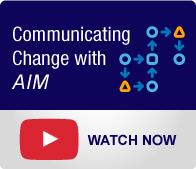Communication during a change is imperative, but in our Change Management Consulting experience we see a lot of the same missteps being made time and time again. Here’s a list of the five most common communication mistakes we see, plus a few great tips on how to fix them! 
Mistake #1: Communication Planning is the ONLY Planning for the People-Side.
There seems to be a common belief that getting a message out to an audience is enough to get buy-in, and even change behavior. This belief is grounded in the assumption that if people just understand the business logic and rationale behind a change they will be on board as champions.
The truth is, when implementing any change, communication is important... but it’s definitely not enough! Think of it this way: if we could change behavior just by communicating more effectively, people wouldn't smoke and everyone would be at their ideal weight.
TIP: In order to achieve successful implementation, a sound change management methodology such as our proprietary Accelerating Implementation Methodology (AIM) needs to be put into place. AIM includes communication planning, but it is only one of the ten elements for implementing organizational change.
Mistake #2: Communication Only Comes From Above.
Getting an email from a high- level executive about the “wonderful rationale” of a change is an all too common occurrence in organizations today. Many leaders simply believe if they send an email to the organization explaining the change, new behaviors will magically appear and there will be no resistance.
 The fact is, resistance to change isn't logical and you will never combat it by communicating elegant messages from the top. During a change, communications need to be sent through a variety of means, and must always provide a feedback loop. Individuals need to have a way to express their thoughts and feelings about the change. Gathering this information can help identify potential sources of resistance.
The fact is, resistance to change isn't logical and you will never combat it by communicating elegant messages from the top. During a change, communications need to be sent through a variety of means, and must always provide a feedback loop. Individuals need to have a way to express their thoughts and feelings about the change. Gathering this information can help identify potential sources of resistance.
TIP: Instead of a barrage of emails, try the more powerful communication delivery mechanism of small face-to-face meetings where resistance can be managed right away. Even in a world of technology, face-to-face discussion remains a powerful method for communication.
Mistake #3: Communication is One-Size-Fits All.
Just as senior executives may think they can send an email explaining the change; all too often they also think one email sent to the entire company will do it. What they fail to take into account is that each Target group needs to be considered differently, and that multiple messaging is needed.
Communications must be translated into the Frame of Reference of the Targets, not the Frame of Reference of top managers. All communication must address the two most important questions from a Target’s point of view: “What’s in it for me” and “What does it mean to me?” But remember, different Target groups have different answers to those questions!
TIP: Develop a communication campaign that emphasizes the reality of multiple Frames of Reference by using different words for different Targets. Don’t hesitate to communicate the same message to the same audience in multiple ways.
Mistake #4: Communication is infrequent/sporadic.
During change, there is often a tendency to wait until all the information is available before sending out communications. But the vacuum created by no communication reinforces the fear of the unknown, which can generate resistance. And remember, resistance will slow down the speed of implementation. 
At the beginning of the project, set the expectation that there will be regular communication that is credible and comprehensive. If you don’t have all the information readily available, tell people what you know, and what you don't know, but that you will come back often as more information becomes available.
TIP: Use frequent repetition of messages throughout the lifecycle of the change. Then evaluate your communications to ensure you are achieving your goals.
Mistake #5: The Same Form of Communication is used for Transformational Change.
If you are going through a transformational change, your communication needs to be transformational, too! Your communication methods must symbolize what you are trying to create, so if you are involved in a transformational, enterprise-wide change, your communication must signal that this change is radically different. You can’t use the same old ways of doing something if what you are trying to tell people is that things are dramatically changing. Remember when Gandhi said, “Be the change?” That applies to your communications, too!
TIP: For transformational changes, use new delivery mechanisms to demonstrate this is radical change. To get the attention of your Targets, don't use the delivery methods of email, town hall meetings or newsletters if those are the methods you typically use.
Communication during change is a must. But avoiding these 5 common mistakes will help accelerate your change, and help to drive accelerated results. What’s your communication plan look like?


